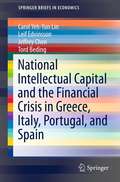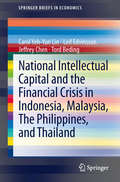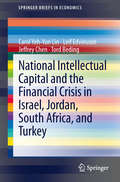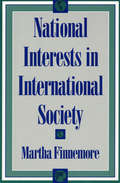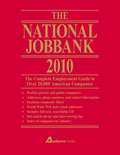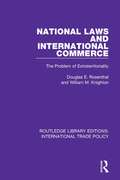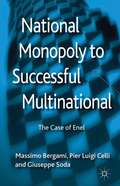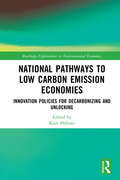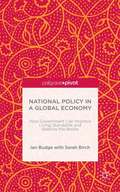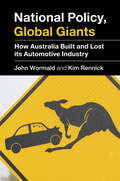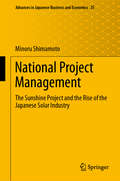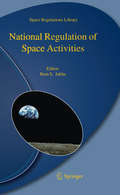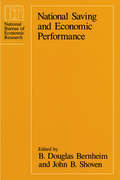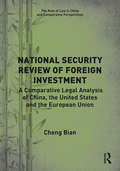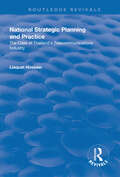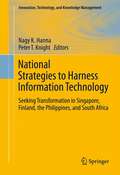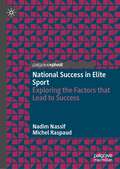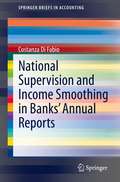- Table View
- List View
National Intellectual Capital and the Financial Crisis in France, Germany, Ireland, and the United Kingdom
by Leif Edvinsson Carol Yeh-Yun Lin Tord Beding Jeffrey ChenIn the first decade of the twenty-first century, the biggest event of worldwide proportion was the 2008 global financial crisis, which was caused primarily by ineffective governance, failed surveillance systems, and implementation flaws. While fiscal and monetary policies succeeded in pulling many countries out of a financial freefall, most economies have performed beneath pre-recession levels as governments continued to struggle with their finances. Examining the financial crisis from the viewpoint of intangible assets provides a different perspective from traditional economic approaches. National Intellectual Capital (NIC), comprised mainly of human capital, market capital, process capital, renewal capital, and financial capital, is a valuable intangible asset and a key source of national competitive advantage in today's knowledge economy. The authors--pioneers in the field--present extensive data and a rigorous conceptual framework to analyze the connections between the global financial crisis and NIC development. Covering the period from 2005 to 2010 across 48 countries, the authors establish a positive correlation between NIC and GDP per capita and consider the impact of NIC investment for short-term recovery and long-term risk control and strategy formulation. Each volume in a series of SpringerBriefs on NIC and the financial crisis provides in-depth coverage of the impact of the crisis, the aftermath, future prospects, and policy implications for a regional cluster. This volume focuses on France, Germany, Ireland, and the United Kingdom.
National Intellectual Capital and the Financial Crisis in Greece, Italy, Portugal, and Spain
by Leif Edvinsson Carol Yeh-Yun Lin Tord Beding Jeffrey ChenIn the first decade of the twenty-first century, the biggest event of worldwide proportion was the 2008 global financial crisis, which was caused primarily by ineffective governance, failed surveillance systems, and implementation flaws. While fiscal and monetary policies succeeded in pulling many countries out of a financial freefall, most economies have performed beneath pre-recession levels as governments continued to struggle with their finances. Examining the financial crisis from the viewpoint of intangible assets provides a different perspective from traditional economic approaches. National Intellectual Capital (NIC), comprised mainly of human capital, market capital, process capital, renewal capital, and financial capital, is a valuable intangible asset and a key source of national competitive advantage in today's knowledge economy. The authors--pioneers in the field--present extensive data and a rigorous conceptual framework to analyze the connections between the global financial crisis and NIC development. Covering the period from 2005 to 2010 across 48 countries, the authors establish a positive correlation between NIC and GDP per capita and consider the impact of NIC investment for short-term recovery and long-term risk control and strategy formulation. Each volume in a series of SpringerBriefs on NIC and the financial crisis provides in-depth coverage of the impact of the crisis, the aftermath, future prospects, and policy implications for a regional cluster. This volume focuses on Greece, Italy, Portugal, and Spain.
National Intellectual Capital and the Financial Crisis in Indonesia, Malaysia, The Philippines, and Thailand
by Leif Edvinsson Carol Yeh-Yun Lin Tord Beding Jeffrey ChenIn the first decade of the twenty-first century, the biggest event of worldwide proportion was the 2008 global financial crisis, which was caused primarily by ineffective governance, failed surveillance systems, and implementation flaws. While fiscal and monetary policies succeeded in pulling many countries out of a financial freefall, most economies have performed beneath pre-recession levels as governments continued to struggle with their finances. Examining the financial crisis from the viewpoint of intangible assets provides a different perspective from traditional economic approaches. National Intellectual Capital (NIC), comprised mainly of human capital, market capital, process capital, renewal capital, and financial capital, is a valuable intangible asset and a key source of national competitive advantage in today's knowledge economy. The authors--pioneers in the field--present extensive data and a rigorous conceptual framework to analyze the connections between the global financial crisis and NIC development. Covering the period from 2005 to 2010 across 48 countries, the authors establish a positive correlation between NIC and GDP per capita and consider the impact of NIC investment for short-term recovery and long-term risk control and strategy formulation. Each volume in a series of SpringerBriefs on NIC and the financial crisis provides in-depth coverage of the impact of the crisis, the aftermath, future prospects, and policy implications for a regional cluster. This volume focuses on Indonesia, Malaysia, The Philippines, and Thailand.
National Intellectual Capital and the Financial Crisis in Israel, Jordan, South Africa, and Turkey
by Leif Edvinsson Carol Yeh-Yun Lin Tord Beding Jeffrey ChenIn the first decade of the twenty-first century, the biggest event of worldwide proportion was the 2008 global financial crisis, which was caused primarily by ineffective governance, failed surveillance systems, and implementation flaws. While fiscal and monetary policies succeeded in pulling many countries out of a financial freefall, most economies have performed beneath pre-recession levels as governments continued to struggle with their finances. Examining the financial crisis from the viewpoint of intangible assets provides a different perspective from traditional economic approaches. National Intellectual Capital (NIC), comprised mainly of human capital, market capital, process capital, renewal capital, and financial capital, is a valuable intangible asset and a key source of national competitive advantage in today's knowledge economy. The authors--pioneers in the field--present extensive data and a rigorous conceptual framework to analyze the connections between the global financial crisis and NIC development. Covering the period from 2005 to 2010 across 48 countries, the authors establish a positive correlation between NIC and GDP per capita and consider the impact of NIC investment for short-term recovery and long-term risk control and strategy formulation. Each volume in a series of SpringerBriefs on NIC and the financial crisis provides in-depth coverage of the impact of the crisis, the aftermath, future prospects, and policy implications for a regional cluster. This volume focuses on Israel, Jordan, South Africa, and Turkey.
National Interests and European Integration
by Katrin MilzowThis study combines an account of Blair, Chirac, Schröder and their attitudes towards European integration. It analyzes political discourses on 'national interests' and the EU, the frequently debated role of political discourse, the concept of national interest, and offers an alternative point of view on intergovernmental interaction.
National Interests in International Society
by Martha FinnemoreHow do states know what they want? Asking how interests are defined and how changes in them are accommodated, Martha Finnemore shows the fruitfulness of a constructivist approach to international politics. She draws on insights from sociological institutionalism to develop a systemic approach to state interests and state behavior by investigating an international structure not of power but of meaning and social value. An understanding of what states want, she argues, requires insight into the international social structure of which they are a part. States are embedded in dense networks of transnational and international social relations that shape their perceptions and their preferences in consistent ways. Finnemore focuses on international organizations as one important component of social structure and investigates the ways in which they redefine state preferences. She details three examples in different issue areas. In state structure, she discusses UNESCO and the changing international organization of science. In security, she analyzes the role of the Red Cross and the acceptance of the Geneva Convention rules of war. Finally, she focuses on the World Bank and explores the changing definitions of development in the Third World. Each case shows how international organizations socialize states to accept new political goals and new social values in ways that have lasting impact on the conduct of war, the workings of the international political economy, and the structure of states themselves.
National JobBank 2010
by Adams MediaAlphabetically arranged by state, this indispensable annual director to over 21,000 employers offers a variety of pertienent contact, business, and occupational data. - American Library Association, Business Reference and Services Section (BRASS) Completely updated to include the latest industries and employers, this guide includes complete profiles of more than 20,000 employers nationwide featuring:Full company name, address, phone numbers, and website/e-mail addressesContacts for professional hiringA description of the companys products or servicesProfiles may also include: Listings of professional positions advertisedOther locationsNumber of employeesInternships offered
National Laws and International Commerce: The Problem of Extraterritoriality (Routledge Library Editions: International Trade Policy #17)
by Douglas E. Rosenthal William M. KnightonThis Chatham House Paper, first published in 1982, examines the problem of extraterritoriality. A wide range of economic activity is subject to the laws of more than one state, yet there is little provision for resolving situations where states impose contradictory requirements. This paper is particularly concerned with four areas of difficulty: extraterritorial anti-trust enforcement; overlapping regulatory claims; economic regulation for political aims; and different approaches to adjudication.
National Monopoly to Successful Multinational
by Massimo Bergami Pier Luigi Celli Giuseppe SodaUsing the Enel case, this volume unpacks the effective implementation of an ambidextrous perspective on adaptation and change, providing some key lessons for managers and scholars. It begins by exploring Enel's recent history, before mapping the steps of a remarkable transition from public monopolist to a successful transnational group.
National Pathways to Low Carbon Emission Economies: Innovation Policies for Decarbonizing and Unlocking (Routledge Explorations in Environmental Economics)
by Kurt HübnerThe science is clear: climate change is a fact and the probability is extremely high that it has been caused by humans. At the same time, policy responses are hesitant, rather lukewarm and differ substantially between nation-states. The question is, what drives and what blocks radical action? This book makes the case that institutional settings, path dependence and emerging change coalitions are critical in explaining climate policies across the global political economy. Technological and social-political innovations are key drivers for dealing with climate change. This class of innovation is very much guided, or suppressed, by a national economy's established institutional settings. By anchoring national case studies in a version of the well established ‘varieties of capitalism’ approach, the chapters of this book show why some economies are policy leaders and others become policy followers, or even policy interlockers. Moreover, the case studies demonstrate the extent to which external events and institutional constraints from the international polity influence national innovation strategies. Taking a unique analytical approach, which combines insights from innovation policies and a variety of capitalism literature, the authors provide genuine comprehension of the interplay between institutional settings, political actors and climate policies. National Pathways to Low Carbon Emission Economies offers a valuable examination of these issues on climate change that will be of interest to academics and postgraduates researching climate policy, economic policy and social movements. Furthermore, it is relevant for policy analysts and policy makers who are interested in learning from climate policies in the context of innovation strategies for a range of countries.
National Policy in a Global Economy: How Government Can Improve Living Standards and Balance the Books
by Sarah Birch Ian BudgeThis study offers an analysis of the UK's current economic policy options and a plan for improving life for ordinary citizens via a sensible and realistic understanding of governments' limited ability to manage economic performance. It provides a manifesto which political parties could immediately adopt to make life better for all.
National Policy, Global Giants: How Australia Built and Lost its Automotive Industry
by John Wormald Kim RennickWhat can we tell about the future of automobiles and the industries that make them by examining their past? Wormald and Rennick trace the history of powered land transport, the rise and fall of the railways, the spectacular rise of the automobile, and what might come next. Delving into the mighty and complex automotive industry, following the growth of the markets and production, this book illustrates the globalization of vehicle manufacturers and component suppliers, giving form to the development of the industry's business model. A key factor in an auto-industry's successes and failures is the often-difficult relationship it has with government, which varies in nature from country to country. As an illustrative case, Wormald and Rennick present and analyse the entire lifecycle of Australia's automotive history – including its birth, growth, functioning and death - and its shifting relationship with the government that supported it.
National Project Management: The Sunshine Project and the Rise of the Japanese Solar Industry (Advances in Japanese Business and Economics #25)
by Minoru ShimamotoThis book clarifies the challenges and outcomes of the Sunshine Project, a national project in Japan for developing new energy that was launched about 40 years ago at the time of the first oil crisis in the early 1970s and ended, as planned, in the early 2000s. The Sunshine Project was the government’s national project for developing new energy technologies such as solar energy and other natural energy sources—what we call renewable energy today. The book considers why policies were successful in some areas but did not have the intended effect in other areas. It explains how technology innovation was employed to achieve energy policy goals and to tackle environmental issues. If we can present suggestions for how to structure national projects, it may also be possible to identify ways for industry, government, and academia to come together to find solutions not only to environmental energy problems, but also to other social problems. Herein lies the goal of this book. Although the development of new energy is the main subject of the book, the author also scrutinizes the governmental decision-making process involved in planning policy, the creative process, and the design of systems of collaboration between industry, government, and academia as well as cases where corporations have developed commercial versions of new energy products. The main part of the book consists of three case studies interspersed with two reflective chapters. The first case study describes the Sunshine Project from the perspective of project management based on the perspective of government. The second case study is a detailed examination of the routines in all organizations, whether industry, government, or academia, and of the autonomy of the project organization. The third case study increases the degree of detail to focus on the smallest unit of analysis, the intentions and motivations of key individuals participating in the project.
National Regulation of Space Activities
by Ram S. JakhuThis book comprehensively addresses all aspects of national space laws and regulations governing the conduct of space activities in fifteen space-faring nations. This is the first book of its kind that contains a compilation of materials written from a neutral and objective perspective by the world's leading space law experts selectively drawn from the fifteen countries whose laws and regulations are covered by the book. In order to provide the reader with a full understanding and appreciation of the various relevant national laws and regulations that govern space activities, this book explores the policies and rationales underlying the law, constitutional basis for the adoption of national space laws, some facts about national space activities in the respective countries, and as well, discusses the relevant principles and rules of international space law in order to bring to light the international context of the national laws described. Since the U.S. presently has the most developed and extensive regime of national space laws and regulations, six chapters of this book are devoted to a thorough examination of those laws and regulations. The unique feature of this compilation is that, apart from the description of applicable national laws and regulations on space activities that it provides, it also sets out the various procedures to be followed particularly by domestic and foreign private entities in order to achieve compliance with the numerous and varied national legal requirements concerning space activities. This work will be a valuable resource not only to students, researchers and academics in the fields of space law and regulation, but also to space industry executives, specialist lawyers, foreign ministries as well as international organizations, such as the United Nations.
National Saving and Economic Performance
by John B. Shoven B. Douglas BernheimThe past decade has witnessed a decline in saving throughout the developed world—the United States has the dubious distinction of leading the way. The consequences can be serious. For individuals, their own economic security and that of their families is jeopardized. For society, inadequate rates of saving have been blamed for a variety of ills—decreasing the competitive abilities of American industry, slowing capital accumulation, increasing our trade deficit, and forcing the sale of capital stock to foreign investors at bargain prices. Restoring acceptable rates of saving in the United States poses a major challenge to those who formulate national economic policy, especially since economists and policymakers alike still understand little about what motivates people to save. In National Saving and Economic Performance, edited by B. Douglas Bernheim and John B. Shoven, that task is addressed by offering the results of new research, with recommendations for policies aimed to improve saving. Leading experts in diverse fields of economics debate the need for more accurate measurement of official saving data; examine how corporate decisions to retain or distribute earnings affect household-level consumption and saving; and investigate the effects of taxation on saving behavior, correlations between national saving and international investment over time, and the influence of economic growth on saving. Presenting the most comprehensive and up-to-date research on saving, this volume will benefit both academic and government economists.
National Security Exceptions in International Trade and Investment Agreements: Justiciability and Standards of Review (SpringerBriefs in Law)
by Sebastián Mantilla Blanco Alexander PehlThis book provides a comprehensive analysis of national security exceptions in international trade and investment agreements. The subject has gained particular relevance in the past few years, as both the United States and the Russian Federation have invoked national security as justification for trade-restrictive measures in the context of WTO dispute settlement proceedings. The book describes the evolution of security exceptions in international economic law, from the GATT 1947 to the most recent economic treaties, such as the 2017 Buenos Aires Protocol for Intra-Mercosur Investment and the 2018 USMCA. Further, it presents an overview of the rich array of adjudicatory practices addressing national security clauses, covering the decisions of WTO dispute settlement bodies, the ICJ, and numerous investment arbitral tribunals. To this end, the book addresses the debates surrounding the alleged self-judging character of security exceptions and the standards of review applicable where the exception is considered to be justiciable.
National Security Review of Foreign Investment: A Comparative Legal Analysis of China, the United States and the European Union (The Rule of Law in China and Comparative Perspectives)
by Cheng BianIn recent years, China, the US, and the EU and its Member States have either promulgated new national laws and regulations or drastically revised existing ones to exert more rigorous government control over inward foreign direct investment (FDI). Such government control pertains to the establishment of an ex-ante review regime of FDI in the host state in sectors that are considered as ‘sensitive’ or ‘strategic’, with an aim to mitigate the security-related implications. This book conducts a systematic and up-to-date comparative study of the national security review regimes of China, the US, and the EU, using Germany as an exampling Member State. It answers a central research question of how domestic law should be formulated to adequately protect national security of the host state whilst posing minimum negative impacts to the free flow of cross-border investment. In addition to analyzing the latest development of the national security review regimes in aforementioned jurisdictions and identifying their commonalities and disparities, this book establishes a normative framework regarding the design of a national security review regime in general and proposes specific legislative recommendations to further clarify the law. This book will be of interest to scholars in the field of international and comparative investment law, investors who seek better compliance programs in the host state, and policymakers who aim for high-quality regulation on foreign investment.
National Security in International and Domestic Investment Law: Dynamics in China and Europe (The Rule of Law in China and Comparative Perspectives)
by Feng Lin Yuwen Li Cheng BianThis book offers a dynamic introduction to the new developments on national security review of foreign direct investment (FDI) from the perspectives of both domestic law and international investment law. COVID-19 and the Russian invasion of Ukraine have intensified FDI screening to an unprecedented scale, yet its purposes, scope and potential impact remain ambiguous and controversial. The book first attests the legitimacy of FDI screening by using the theory of National Security Constitution. Part I explicates the national security, public order and public health exceptions clauses in international investment law and the novel EU Regulation on FDI screening. Part II provides an in-depth analysis of FDI screening in China, France, Germany, Italy, the Netherlands, Poland and the UK, which have either witnessed momentous changes in domestic law recently or have adopted new laws to cope with the growing security concerns. The book illustrates how States and the EU are using legal instruments to tackle exigent and emerging challenges and the complexity of national security emanated from foreign investment, in the context of evolving disruptive digital technologies and the structural change of the global economy. The volume will be of great value to a wide range of audiences including academics in investment and trade law, legal practitioners, in-house counsels, policymakers, business professionals and law and business students at the graduate level.
National Semiconductor's India Design Center
by Liz Kind Jeffrey T. PolzerThe senior managers of the India Design Center used 360-degree feedback to develop their team competencies. Now, three new managers are about to join their management team, and Ashok Kumar, director of the center, must decide how to integrate the new managers in a way that maintains the team's newfound trust and camaraderie. Describes the managers' work activities, including engineering, human resources, and finance responsibilities, to allow a diagnosis of how the managers can benefit from working together as a team. Also notes the challenges these managers face as they work with their bosses and counterparts at the company's headquarters in California, which is 13.5 time zones away. The team is one that could presumably benefit from better cross-functional coordination and communication regarding their collective relationship with the company's headquarters in California.
National Solutions to Trans-Border Problems?: The Governance of Security and Risk in a Post-NAFTA North America (The International Political Economy of New Regionalisms Series)
by Isidro Morales'Triggered by the North American Free Trade Agreement (NAFTA), Canada, the United States and Mexico redefined their public policies to facilitate the regionalization of transactions. However, this volume addresses the institutional gaps that still remain focusing mainly on the cross-border governance of security aspects. It gathers interdisciplinary contributions of specialists working on continental issues within Canada, the United States and Mexico and highlights the transnational dimension of certain issues still managed under national-framed policies. Furthermore, it explores the possibilities and constraints for moving public policy into new cross-border governance strategies. Divided in three parts, the first part assesses what is at stake in cross-border governance issues and whether the integrative trend in the region will be maintained or stalled in the years to come. The second part explores the growing scope of security problems interconnected with borders, migration, energy and drug trafficking across the region. It highlights how Mexico and Canada are responding or adapting their policy choices to a continental security approach framed by the US after the terrorist attacks of September 11, and to the major concerns of the Obama administration. The third part focuses on the governance of territorial borders and bilateral affairs, i.e. Mexico-US and Canada-Mexico relations.
National Storage Affiliates: The REIT IPO Decision
by Charles F Wu Gregory Himmel Max de la BruyereCase
National Strategic Planning and Practice: The Case of Thailand's Telecommunications Industry (Routledge Revivals)
by Liaquat HossainThis title was first published in 2001. This text explores the relationship between telecommunications strategic planning process (TSPP), the organization and the environment for developing an understanding of the idea of a national TSPP (NTSPP) in Thailand. The overall aim is to explore an understanding of an NTSPP by providing a detailed study of the strategic planning and practices of the Thai telecom regulators during the period from 1954 to 1996. It applies the strategic planning process principles to further the understanding of NTSPP in Thailand. By using the SPP framework, the study develops a theoretical TSPP framework for analyzing the underlying TSPP strategies within the national telecom regulators in Thailand. It also seeks to illustrate the limitations of the traditional strategic planning theory when applied to NTSPP. From a theoretical perspective, this book illustrates that a lack of formalization and consensus in Thailand's NTSPP is the fundamental backlog for the successful operation of its industry.
National Strategies to Harness Information Technology
by Nagy K. Hanna Peter T. KnightThe ability to harness Information Communication Technologies (ICTs) is increasingly at the heart of competitiveness and sustainable growth. As countries engage in an increasingly competitive global economy, they are trying to weave ICT into their development strategies, in the same way enterprises have learned to use ICT to transform their business models and strategies. This integration offers a new path to development that is responsive to the challenges of our times. In National Strategies to Harness Information Technology, Nagy Hanna and Peter Knight provide a framework for assessing the opportunities, challenges, and prospects for "e-transformation" and for analyzing the options and innovations adopted to manage the e-transformation process. They ask hard questions: what does it take to harness ICT to transform an economy? Why some countries accelerate their development journey with ICT while others fail? How did successful countries balance the need for strategic leadership with bottom up innovation? Can countries reduce the risks of digital divide? What have been the roles of government and private sectors? What lessons can be learned for countries at different levels of development? Featuring contributions from country experts, the editors and authors provide in-depth case studies of ICT deployment in Singapore, Finland, the Philippines, and South Africa, and asses the progress of such efforts. The result is an essential resource for academic researchers, policy analysts, policymakers, and industry leaders interested in the role of ICT in national development, innovation, and economic growth. In National Strategies to Harness Information Technology, Nagy Hanna and Peter Knight provide a framework for assessing the opportunities, challenges, and prospects for "e-transformation" and for analyzing the options and innovations adopted to manage the e-transformation process. They ask hard questions: what does it take to harness ICT to transform an economy? Why some countries accelerate their development journey with ICT while others fail? How did successful countries balance the need for strategic leadership with bottom up innovation? Can countries reduce the risks of digital divide? What have been the roles of government and private sectors? What lessons can be learned for countries at different levels of development? Featuring contributions from country experts, the editors and authors provide in-depth case studies of ICT deployment in Singapore, Finland, the Philippines, and South Africa, and asses the progress of such efforts. The result is an essential resource for academic researchers, policy analysts, policymakers, and industry leaders interested in the role of ICT in national development, innovation, and economic growth.
National Success in Elite Sport: Exploring the Factors that Lead to Success
by Michel Raspaud Nadim NassifThis book takes a deep dive into the factors that lead to countries’ success in elite sport. While some researchers have suggested looking at the political, economic, demographic, geographic and cultural characteristics of a country, other scholars have advocated that meso-level strategies such as financial support, governance, and talent identification systems are the factors that need to be taken into consideration. Taking into account the two sides of this debate, the authors review and evaluate these various components. They go on to use this review to propose a new holistic framework of analysis that includes the macro, meso and micro-level factors that lead to national success in elite sport. This is a valuable resource for researchers and students interested in sport management, particularly the subject of sport governance. In addition, sports consultants and policymakers will find this to be an eye-opening read.
National Supervision and Income Smoothing in Banks’ Annual Reports (SpringerBriefs in Accounting)
by Costanza Di FabioThis book deals with the debated relationship between the characteristics of national supervision and manipulative practices in banks’ annual reports, with a specific focus on income smoothing. The issue is quite challenging as, since the 2008 financial crisis, governmental bodies and regulators have stressed the crucial role of supervision for bank transparency purposes, but the effect of supervision on accounting manipulation is still discussed. Focusing on European banks, the book investigates whether the characteristics of national supervision affect bank propensity to smooth income, also considering the potential role of bank business models. By exploring a broad range of national supervision’s characteristics, the book presents a comprehensive view on the influence of country-level institutional settings on a form of earnings management widely used across the banking industry.

